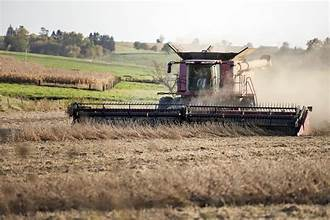Across the United States, soybean farmers are growing increasingly concerned about the uncertain state of the soybean market. With dropping prices, global competition, and policy confusion, their worries are not unfounded. Many farmers are seeing thinner profit margins and are questioning the sustainability of their operations.
Soybeans are one of America’s top agricultural exports, especially to countries like China. But changes in trade policies, rising production in Brazil and Argentina, and demand fluctuations are affecting the price and confidence of U.S. growers.
According to the U.S. Department of Agriculture (USDA), soybean prices have dropped by nearly 15% since the beginning of the year. This has triggered a chain of fear in farming communities already battling high input costs and climate variability.
Global Competition Squeezing U.S. Soybean Export Power
Brazil and Argentina Expand Their Market Share
One of the major issues facing U.S. soybean farmers is increased global competition, especially from Brazil and Argentina. These two South American countries have significantly ramped up soybean production, benefiting from favorable weather and lower production costs.

Brazil is now the world’s top soybean exporter, overtaking the U.S. in recent years. The global supply chain shift has pushed international buyers to look elsewhere, which hurts American farmers who rely heavily on exports to keep their businesses profitable.
As reported by Reuters, Brazil exported over 14 million metric tons of soybeans in April 2024 alone, setting a new record.
Price Fluctuations Add to Farmers’ Economic Strain
Lower Soybean Prices Mean Smaller Profits and Bigger Risks
Farmers say falling prices are the most immediate threat. In 2022, soybean prices hovered around $14 per bushel. As of May 2025, the prices have dipped below $12 per bushel, a sharp drop that affects profit margins and financial planning.
Many farmers are locked into high input costs — including fertilizers, seeds, fuel, and labor. When prices fall and costs remain high, it creates a financial trap that many cannot escape.
“We’re not making enough to break even,” said Mark Robbins, a soybean farmer in Iowa. “The price per bushel just doesn’t cover what it costs us to grow the crop anymore.”
Trade Tensions and Policy Changes Create Uncertainty
Farmers Want More Clarity on Tariffs and Export Policies
Another factor shaking the soybean market is international trade policy. The recent back-and-forth between the U.S. and China over tariffs still lingers in the minds of many growers. Although relations have improved, the long-term trust and stability needed for a consistent export market are still shaky.

U.S. farmers are urging policymakers to prioritize stable trade agreements and minimize unpredictable tariffs. They’re also calling for better support programs and crop insurance to protect against market volatility.
“Trade wars hurt rural America more than anyone else,” said Lisa Thompson, an agricultural economist. “When markets shut down or slow down, farmers are the first to suffer.”
Climate Conditions Also Threaten the Soybean Season
Droughts and Floods Make Yields Less Predictable
Aside from economic challenges, soybean farmers are also battling unpredictable weather. In some regions, drought conditions are reducing yields. In others, excessive rainfall is delaying planting or damaging crops.
According to a recent report from NOAA, large parts of the Midwest are likely to experience above-normal temperatures and below-normal rainfall this summer. These conditions could further damage soybean crops and impact national supply.
Climate risk is another reason why many farmers are reluctant to invest heavily this season, as they fear poor returns from both market and environmental sides.
Supply Chain Delays Add to the Frustration
Transport and Shipping Costs Hurt Soybean Profits
Even when soybeans are grown successfully, getting them to market has become more expensive and complicated. Shipping container shortages, high fuel costs, and port congestion are eating into already tight profits.
In the past, farmers relied on efficient rail and trucking systems to move their products. Now, delays and rising logistics expenses mean farmers have to wait longer and earn less.
“Every extra day our product sits unsold costs us money,” said John Martinez, a Kansas-based grower.
What Farmers Are Asking for Right Now
Better Government Support and Fair Trade Conditions
Farmers are calling for immediate steps to stabilize the soybean market. Key demands include:
- Strengthening trade relations with major buyers like China and India
- Expanding crop insurance and emergency relief programs
- Improving infrastructure to reduce shipping delays
- Supporting research on climate-resilient soybean crops
Groups like the American Soybean Association have also urged Congress to act quickly on these issues. Their recent statement urged bipartisan support for the 2025 Farm Bill, which is expected to include provisions for crop insurance expansion and international marketing funds.
More about their advocacy can be found on the American Soybean Association’s website.
The Road Ahead: Is Recovery Possible?
Experts Say Change Is Possible but Needs Strong Policy Push
While the current scenario looks bleak, agricultural experts say the market can recover if the right steps are taken. This includes reducing trade barriers, investing in infrastructure, and addressing climate resilience in farming practices.
Consumers can also play a role. By supporting domestic soybean products and learning about farming challenges, they can help build a more sustainable food system.
“There’s no silver bullet,” said Thompson, the economist. “But with smart policy and strong community support, we can turn the tide.”
Final Thoughts: Soybean Farmers at a Crossroads
The soybean market in the U.S. is going through a rough patch — one shaped by international trade shifts, climate extremes, and economic pressures. Unless steps are taken quickly, the livelihood of thousands of farmers could be at risk.
For now, soybean growers are waiting — not just for better prices but for signs that someone is listening and ready to act.e





